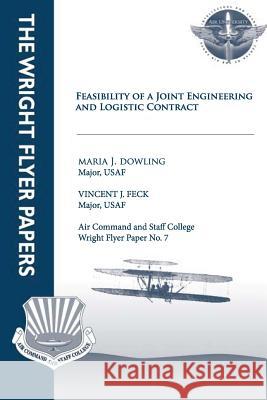Feasibility of a Joint Engineering and Logistics Contract: Wright Flyer Paper No. 7 » książka
Feasibility of a Joint Engineering and Logistics Contract: Wright Flyer Paper No. 7
ISBN-13: 9781479206414 / Angielski / Miękka / 2012 / 56 str.
The Army, Air Force, and Navy currently manage their own separate engineering and logistics contracts for employing civilian contractors as a force multiplier during military operations. Civil augmentation contracts afford flexibility when the services are limited by the availability of manpower resources during contingency operations. Allocation of military forces is often constrained by other contingency commitments, inactivation of reserve components, and political considerations with a host nation. The Army first awarded the Logistics Civil Augmentation Program (LOGCAP) contract in 1992. The Navy awarded the Construction Capabilities Contract (CONCAP) in 1995 and the Air Force followed suit with the Air Force Contractor Augmentation Program (AFCAP) contract in 1997. A General Accounting Office (GAO) report published in 1997, however, questioned the validity of executing three separate contracts and stated that it might be more "effective and efficient" if one service acted as the lead executive agent to eliminate duplication of services. The GAO report also noted that existing military doctrine was vague in addressing how to integrate contractor resources properly with the military force structure during contingency situations. This research paper addresses two of the important questions raised in the GAO report regarding the use of contractors in support of joint military operations. First, will a joint engineering and logistics service contract provide the combatant and service commanders any benefit over maintaining individual Navy, Army, and Air Force service augmentation contracts? Second, does current joint doctrine adequately address the use of contractor services in support of contingency and wartime operations? If not, what information should be included in future joint doctrine? In conducting our research, we performed in-depth comparative analyses of the Army's LOGCAP and Air Force's AFCAP contracts, but the Navy CONCAP contract was not analyzed in depth because of its limited scope. We conducted interviews with key government personnel affiliated with the Army and Air Force contracts to include the AFCAP and LOGCAP program managers and contracting staffs. We also performed historical research using source material from several Department of Defense agencies. This research project provides an objective review of the benefits and drawbacks of the Army's LOGCAP and Air Force's AFCAP contracts. Since the scope of the two contracts is similar, it is our recommendation that a joint civil augmentation program (JCAP) contract be established that will meet the needs of both services while eliminating duplication of effort. For JCAP to be a viable option, joint doctrine must be developed to provide guidance on when and how to use a civil augmentation contract during military operations.
Zawartość książki może nie spełniać oczekiwań – reklamacje nie obejmują treści, która mogła nie być redakcyjnie ani merytorycznie opracowana.











